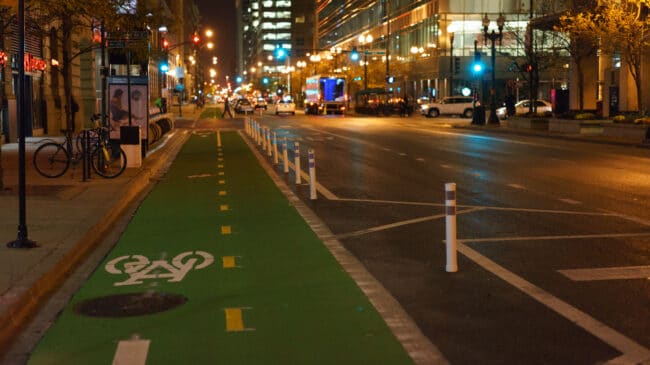For many years, Smart Growth America and other organizations have urged state and local governments to require that all roadways accommodate all users, including cyclists and pedestrians. In some cases, they urge that existing motor vehicle lanes be converted to alternative uses, such as bus-only lanes, protected bike lanes, and wider sidewalks. A number of state transportation departments have adopted some form of complete streets policy, sometimes choosing Smart Growth America as a consultant.
Short stretches of some downtown streets have been made more attractive by such changes, especially if additional off-street parking is made available for those who live farther than walking or biking distance from those downtowns.
But an often-unasked question is: What categories of roadways are not suitable for this kind of makeover?
No one is proposing that urban freeways and Interstates have bike lanes and sidewalks. The safety consequences for cyclists and pedestrians would be dire, due to the high likelihood of deadly collisions. But what about roadways that are intermediate between local streets and many-lane, high-speed, limited-access highways?
These intermediate roadways are called major arterials. In most metro areas, they have from four-to-eight lanes of traffic. The posted speed limit is typically around 40-to-45 miles per hour. Arterials also typically have raised medians that prohibit most, or all, left turns, except at signalized intersections. In many cases, arterials have limited, or no, direct access to retail or commercial establishments in order to minimize accidents and maintain traffic flow. Major arterials are intended to be prime commuter and commercial highways, serving as an important supplement to an area’s freeway system.
Bicycle and pedestrian advocates understandably decry the extent of collisions between motor vehicles and cyclists and pedestrians on these arterials. To reduce the likelihood of bicyclist and pedestrian fatalities, they call for lower speed limits and protected bike lanes (to reduce the number of car/bike/pedestrian collisions).
The alternative to converting a major arterial to a quasi-complete-street is to decide that cyclists and pedestrians should not use these specific highways because the risk to them is too high. Parallel avenues and boulevards, with fewer lanes and lower speed limits, are a far-safer alternative for cyclists and pedestrians.
State Departments of Transportation (DOTs) should amend their complete streets policies to explicitly exclude major arterials, which are often state highways, managed and maintained by the state DOT, consistent with their role in supplementing the freeway system.
Pavement striping for bike lanes on major arterials should be removed. If sidewalks already exist on a major arterial, railings should be installed to deter pedestrians from stepping off the sidewalk between signalized intersections (where most auto/pedestrian collisions occur).
“Over the period from 2009 to 2018, pedestrian fatalities in the United States increased 53 percent, from 4,109 to 6,283,” the AAA Foundation for Traffic Safety found in “Examining the Increase in Pedestrian Fatalities in the United States, 2009–2018.” “The number of pedestrians fatally struck at non-intersection locations on urban non-freeway arterials more than doubled over the study period, which alone accounted for 56 percent of the entire increase in pedestrian fatalities.”
Rather than having bikes on high-speed, high-volume arterials, county and city governments should revamp their bike lane systems to provide alternative bike and pedestrian routes that parallel the major arterials.
Ultimately, complete streets can make certain neighborhoods, particularly shopping districts, more pleasant and economically viable. But this approach is incompatible with the vital role in regional multi-modal (car, bus, and truck) mobility that major arterials are designed to provide.
Reason’s Debatable Ideas series examining transportation and infrastructure issues is available here.

